![]()
![]()
![]()
Use LEFT and RIGHT arrow keys to navigate between flashcards;
Use UP and DOWN arrow keys to flip the card;
H to show hint;
A reads text to speech;
43 Cards in this Set
- Front
- Back
|
That the systems described below provide the needs of cells to survive and thrive. |
that the systems described below provide the needs of cells to survive and thrive. |
|
|
What is the role of cellular respiration? Where does it happen in cells? |
cellular respiration provides cells with energy. This occurs in the Mitochondria. |
|
|
What does the cell need for cellular respiration? What wastes are made? |
Oxygen and glucose are needed. Carbon dioxide and water are produced. glucose + oxygen = carbon dioxide + water + energy |
|
|
How does the body provide the needed substances and remove the wastes? |
The oxygen diffuses into the bloodstream from the alveoli and is carried by the red blood cells. The glucose is diffused into the bloodstream after being digested from carbohydrates in the digestive system. The carbon dioxide dissolves into the blood plasma and is carried to the lungs. Excess water can be excreted via the kidneys or skin (sweat). |
|
|
which has the thickest walls- Arteries, veins or capillaries? why? |
Arteries are the thickest,this allows arteries to cope with blood at a much higher pressure than veins. |
|
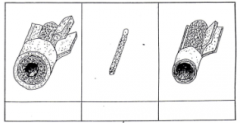
label this diagram. |
1. artery 2. capillary 3. vein |
|
|
Which side of the heart deals with the oxygenated and which side of the heart deals with the deoxygenated blood? |
the right side of the heart deals with the deoxygenated blood the left side of the heart deals with the oxygenated blood. |
|
|
what is the direction of blood flow in the heart? |
Blood enters the heart into the right atrium via the largest veins in the body (the inferior and superior vena cava), then into the right ventricle. the muscles contract, pushing the blood into the pulmonary Arteries (the arteries to the lungs). the blood returns from the lungs and into the left atrium. The muscles push the blood into the left ventricle. The blood then gets pushed through the aorta into the rest of the body. |
|
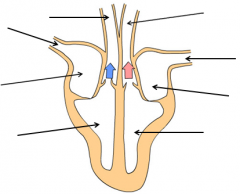
label this diagram. |
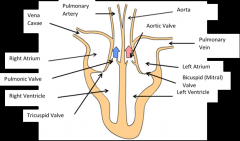
|
|
|
What are the names of the different types of blood cells, the liquid part of the blood and the functions of each blood component? |
Functions: White blood cells- Protect the body from disease. Platelet- Involved in blood clotting. Plasma- Carries nutrients, hormones and wastes. Red blood cells- To carry oxygen to the cells. |
|
|
Which blood vessels have valves and why are they necessary in these but not the others? |
Veins have valves. The blood pressure is lower in the veins than in arteries, so no longer enough to push the blood through. Returning blood also may have to travel against gravity, valves stop the blood flowing backwards. |
|
|
What is the role of the lymphatic system? |
to drain fluid from around the cells and return it towards the heart after passing it through the lymph nodes (exposing it to the immune cells). |
|
|
What percentage of the blood is: a) Plasma? b) Blood cells? |
a) 55% b) 45% |
|
|
Which walls of the heart are thicker the LHS or the RHS? Why? |
The left hand side is thick as it needs to push the blood out of the heart and around the body. |
|
|
Where are blood cells made? |
In the Bone Marrow |
|
|
Which type of blood cell carries O2 and how is it able to do this? |
Red blood cells. The specific shape of the proteins and haemoglobin allows it to be carried. |
|
|
What is needed in our diet for these cells to be able to be made efficiently? |
Iron |
|
|
What id the difference between cellular respiration and breathing? |
Cellular respiration is the break down of glucose with O2 in cells to produce energy. Breathing is inspiration and expiration (gases entering and leaving the lungs). |
|
|
How does the lung achieve such a huge surface area for gas exchange between the bloodstream and the atmosphere in such a small volume? |
Millions of thin, folded alveoli allow a large surface area to be in a small volume. |
|
|
what is the name of the functional unit it is made up from? |
The alveolus |
|
|
Where is mucus produced? a) goblin cells b) guard cells c) ciliated cells d) goblet cells |
Goblet cells |
|
|
What is the role of the cilia in the respiratory tract? |
Cilia are little hairs in the respiratory tract. They move back and forth to push mucus and trapped particles out of the respiratory tract (imagine a crowd surfer being moved along the top of people's hands). |
|
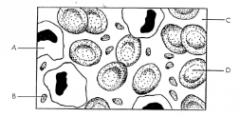
label this diagram |
a) White blood cell (lymphocyte) b) Platelet (thrombocyte) c) Plasma d) Red blood cell (erythrocyte) |
|
|
Label this diagram |
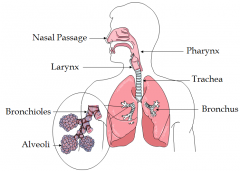
|
|
|
would blood leaving the site of an alveolus have a high or a low O2 concentration compared to blood entering this site? Reason? |
high O2 concentration. O2 has just diffused into the blood. |
|
|
Which two set of muscles are involved in breathing? |
the Intercostal muscles and the diaphragm. |
|
|
In terms of the intercostal muscles, diaphragm, relative air pressures in lungs and atmosphere, volume of the chest cavity and movement of the rib cage, explain inspiration. |
the diaphragm contracts (when the ribs lift up and outwards) and the chest cavity gets bigger. this helps to lower the air pressure in the lungs and thus cause inspiration (breathing in). Air moves from an area of higher pressure to lower pressure, and the pressure is now higher outside the body, making the air move into the lungs (towards the area of low pressure). |
|
|
In terms of the intercostal muscles, diaphragm, relative air pressures in lungs and atmosphere, volume of the chest cavity and movement of the rib cage, explain expiration. |
When the diaphragm relaxes (and the ribs fall back into their original place) the chest cavity is now smaller. This increases the air pressure in the lungs, causing expiration (breathing out). Now the air in the lungs is higher than that outside of the body, so the air moves towards the lower air pressure (ie out the body). |
|
|
Why is it better to breathe through your nose than through your mouth? (4 reasons) |
a) the air is moistened b) the air is warmed c) the air is filtered d) the air is tested by smell for safety |
|
|
What would be the problem if we did not have cartilage rings in our trachea? |
The airway would not be maintained whilst food was being swallowed. |
|
|
What process happens to allow gas exchange to occur between the atmosphere and the bloodstream. |
Diffusion (the gases dissolved into the moist surfaces and diffuse between the blood and lungs). |
|
|
What do we suffer from if we have a poor diet? |
Malnutrition |
|
|
label this diagram |
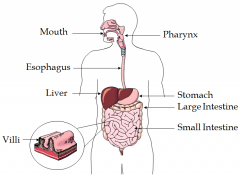
|
|
|
What structure provides the increased surface area for absorption in the intestines? |
Villi |
|
|
Where are the nutrients absorbed into the body? |
The small intestine |
|
|
Where are water and minerals absorbed into the body? |
The large intestine |
|
|
Define a hypothesis. |
A tentative idea to be tested in an investigation started as the relationship between the independent and the dependent variables. |
|
|
Do you arrive at a hypothesis before you set out on a practical investigation on afterwards (in a properly set up investigation)? |
Before you start the investigation. |
|
|
What is your hypothesis based on? |
The relationship between the independent and dependent variables in the experiment. |
|
|
Why do we need a control set up in a well designed investigation? |
This data is used to serve as a point of comparison with the data collected in the main investigation. |
|
|
What is a systematic error? |
These errors are associated with the experimental design or the equipment being used. They are therefore consistently wrong throughout the experiment. Repeating experiments can find these. e.g. The equipment is not calibrated correctly or a controlled variable is not controlled well enough. |
|
|
What is an independent versus a dependent variable? |
Independent variable: The variable that is changes in an investigation to see what effect it has on the dependent variable.
Dependent variable: The variable that changes in response to changes in the independent variable. Often the variable that is measured in an investigation. |
|
|
is the independent or the dependent variable manipulated in an investigation? |
The independent variable is manipulated in an investigation. |

